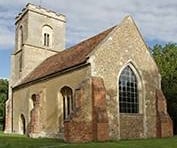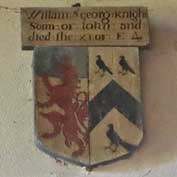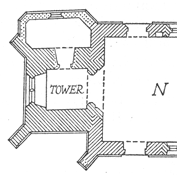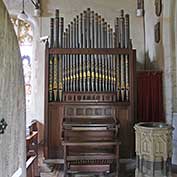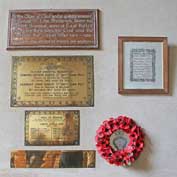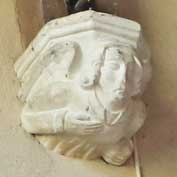Text and photos: Peter Mann
Hatley St George church is a Chapel of Ease in the Parish of Gamlingay, which puts it one notch down from being a parish church – however, it can be used for christenings, weddings and funerals.
The official name of the church is ‘Chapel of St James the Greater’ – and not, as it may seem, ‘St George’ (which refers to the St. George family who gave their name to the village in the 14th century).
St James the Greater was the son of Zebedee. He was one of the Twelve Apostles of Jesus and among the first to join him – with John and their father, they were by the seashore when Jesus called them to follow him. If you’d like to know more about James, do go to the Wikipedia page.
- Hatley St George church is normally locked, although the key can be obtained from the farmhouse opposite.
- Services are only held on special occasions (e.g Easter, Harvest Festival, Christmas Carol service) – see our ‘services’ page.
- Online giving: St Mary’s Gamlingay carries the financial commitment for Hatley St George’s church, which is incorporated into the parish; your donation goes to the Gamlingay with Hatley St George and East Hatley Parochial Church Council.
- A [Facebook] 360° view of Hatley St George church by Alex Brad of 360 Deaneries, 6th February 2023.
- Music – Ave Maria (the Gounod/Bach setting) in Hatley St George church – played by Two Lads and a Laptop.
- Churchyard regulations for graves – Diocese of Ely’s guide for families and next-of-kin (revised October 2024).
Before Domesday?
As Hatley St George is mentioned in the Domesday Book of 1086, there would almost certainly have been a church here too, although there is no record of its location. So, when was it built?
Well, Henry II, perhaps atoning for the murder of Thomas à Becket, the Archbishop of Canterbury, in 1170 began a huge revival in ecclesiastical building – which almost certainly eventually filtered down to villages like Hatley St George and East Hatley.
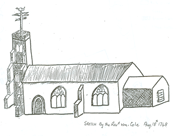
Revd William Cole’s sketch of Hatley St George church, 18th Aug 1748; the chancel was demolished in 1966. From Cambridgeshire Family History Society’s Monumental inscriptions of the church,1709-1982.
Indeed, in 1217 it was included in the Taxatio records (published in 1291) made at the time when all ecclesiastical properties were accessed for tax, well before the 1352 commonly quoted – that is when, according to W M Palmer in his paper A history of Clopton (page 35), there is record of a visit by Bishop Lisle to dedicate ‘a new church at Hatley St George’ on 2nd October 1352 (which rather demolishes modern-day experts who reckon it to be ‘somewhat later’**). It was rebuilt between 1873-78 by the then lord of the manor, John Carbery Evans JP. His coat of arms is on a tile near the altar.
A local newspaper (title unknown) reported on the re-opening of the church in 1892:
‘Everything except the walls is new, at least on the inside, thanks to John Carbery-Evans. The architect was John Bird of Brampton, who mostly copied what was there before. All the windows except the chancel [and probably the tower] are now stained glass, designed by the Cambridge artist William Henry Constable [the link is to Sussex parish churches and lists an enormous number of artists, so you’ll have to scroll well down the page to find the Constable entry]. The encaustic tiles are by Minton. There was an opening party with a marquee and 200 guests to celebrate.’
On 7th November 1902, the Royston Crow reported:
‘A new vestry has been added at the West end, the gift of Sir Charles Hamilton of Hatley Park. The old vestry at the North end is now the organ chamber. The belfry has been used as a vestry until now.’ [If you click on the plan of the church below, there’s no sign of a vestry, although Sir Charles did own Hatley Park at the time; presumably it was demolished with the chancel in 1966.]
Like St Denis‘ church in East Hatley (which the bishop visited a few days later), Hatley St George church is Grade II* listed and, as with many churches in South Cambridgeshire, it is constructed of field stones and rubble, cemented over inside and out – while this looks neat, it’s not good for the fabric of the church, for it prevents the walls from ‘breathing’ and thereby attracts damp.
Special features
While it is certainly true to say every parish church is different, some especially so (e.g. St Mary’s, Gamlingay), Hatley St George church has two special features: no separate chancel (the area with the altar and where the choir would sit) and 28 wooden shields, 20 with rounded ends painted with the arms of the St. Georges and eight, with pointed ends, for the Cottons.
A few years ago there was talk of a rich American with St. George ancestry paying to have the shields repainted, but nothing seems to have come of this, which is a pity. There’s a little more about the shields in this article: A walk through Hatley history.
There was once a chancel, but it was demolished in 1966, presumably because the clay on which the church is built, heaved and hoed too much, a shame because losing it virtually halved the length of the church: imagine how imposing it must have looked – click on the graphic below for an idea (published in An Inventory of the Historical Monuments in the County of Cambridgeshire, Volume 1, West Cambridgeshire).
In its place is an unusual plain glass east window, which brings plenty of light into the church and affords a view of a fine beech tree and lovely sky; in 2011 it inspired Malcolm Guite to write Hatley St George – these are its opening lines:
Stand here a while and drink the silence in.
Where clear glass lets in living light to touch
And bless your eyes. A beech tree’s tender green
Shimmers beyond the window’s lucid arch.
Olivia Drake created a beautiful piece of calligraphy of the poem – it’s now on permanent display in the church. Sadly, a year or so after Malcolm wrote his poem, the tree nearest the church was found to be diseased and much of it was cut down.
- Use this link for the complete poem…
- …and this link to Malcolm Guite’s website where he explains how he came to write it.
The font (of polished limestone) and the organ, built by Bevington & Sons of London in 1878, were also part of John Carbery Evans’ rebuild of the church.
It is one of Bevington’s Model 5 organs and stood in a chamber / vestry on the south side of the old chancel. It was moved to its current position by Arnolds of Thaxted in 1962 when its width was reduced slightly and an electric blower added. It was cleaned and overhauled by Norman Hall & Sons of Cambridge in 2000 – and is still going strong. You can read about the organ on this page.
The tower, added in the late 14th- or 15th-century, contains three bells; two of them are 17th century, but the tower and bell frame aren’t strong enough to allow them to be rung. The third bell is the old(ish) sanctus bell from St Denis’ church in East Hatley.
Bells
Laurence Drake writes: The two original bells were lowered from their decaying wheels to rest safely on thick packing timbers, after being last rung in the 1970s.

Revd Steve Rothwell, Laurance Drake, William Drake and John Boocock after the ‘new’ sanctus bell was first rung, April 2014.
In April 2014 John Boocock, Tower Captain of St Mary’s church, Gamlingay, and I designed a stout timber frame of a cubic metre to take the small ‘St Denis’ sanctus bell.
With my son William (as part of his Silver Duke of Edinburgh Community Award work at the church) we built the frame with wood donated by Trulight Windows, Croydon.
The three of us hoisted it up in sections through the tight hatch and fixed it securely to the high first floor in the tower. The spring loaded clapper is rung by rope running over a pulley.
The ‘new’ sanctus bell was first rung at a joint Benefice service for Palm Sunday in 2014 where villagers were joined by congregations from Gamlingay and Everton. The Revd. Steve Rothwell (our vicar at the time) blessed the bell at the service, saying “It’s wonderful to have a bell ringing again in this beautiful church, after such a long time without one.”
Although it is rather quiet (being a lightweight sanctus bell), it is rung on special occasions – such as on 11th November 2018, Remembrance Sunday, as part of a nationwide ‘ringing for peace’ to commemorate Armistice Day, 100 years after the official end of World War I.
Monuments and memorials
The are some rather good monuments in the church, including those to Baldwin St. George of 1425 and Catherine Docwra from 100 or so years later which was originally in St Denis’ church in East Hatley and moved to Hatley St George church in 1961, a couple of years after St Denis’ was closed.
There are stone tablets to:
Thomas Thory (1709) and Elizabeth his wife (1712).
John Thory (1725).
Best Pearse (1796) and his wife Sarah (1808), Edward Enfield (1818) and Augusta Elizabeth Enfield, daughter of Best Pearse (1837).
Elizabeth Quintin (1801) and John Whitby Quintin
Thomas Quintin (1806).
Alice Harriet Evans (1889) and her husband John Carbery Evans (1893), complete with a ships’ anchor in stone.
There are also four memorials and a calligraphy to the men who fought and died in the two world wars from Hatley St George and East Hatley:
To the Glory of God and in grateful memory of
Ernest W Lyon
Frederick Starr
Albert Warmun
Men of East Hatley who gave their lives for God and the Right in the Great War 1914-1918. This tablet was erected by friends and neighbours.
Roll of Honour
This tablet was erected in honour of the men of this parish [Hatley St George] who served their King and Country in the Great World War 1914-1919
Drace L.H. 1st Cambs
Dickerson H. 2nd Suffolk
Gilbert A.W. 12th Suffolk
Green A.F. R.A.S.C
Harvey L. 1st Cambs
Jarvis E. 1st E.Kent
Jackson W. R.A.S.C
Kimpton C. R.F.A
Kimpton S. R.F.A
Kimpton A. R.F.A
Kimpton H. 2nd R.W. Surrey
Leonard S.A. 4/5 Middlesex
Smith C. R.F.A
Titchmarsh S. R.A.S.C
In ever grateful memory of
Edmund Arthur Baker. 1st Batt Cambs. Regt. Killed in Action in France 13th April 1915. Aged 22 years
Herbert John Baker. 1st Batt Cambs. Regt. Died of Wounds in Belgium 6th October 1917. Aged 23 years
“They died the noblest death a man my die, fighting for God, and Right, and Liberty.”
Requiescat in pace.
Roll of Honour
of those men of this parish who served their country in the world war of 1939-1945
Cpl William Whitbread RAF
Pr. Leslie Hughes RA
Pr. Frederick Starr RAMC
Pr. James Presland RAMC
L/Bomb George Holmes RA
L/Cpl. Thomas Hood RA
Roll of Honour
1914-1918
East Hatley
Population in 1911 – 78
Herbert Chessum. Wounded twice. 4th Bedfordshire.
Henry Dickenson. 2nd Suffolks.
K. Bond Smith. Wireless Service.
Frederick Starr. Killed Nov 15th 1916. Hampshire.
Cpl. Harry Starr. Wounded. 1st Cambridgeshire.
Albert Warmun. Wounded twice. Died prisoner of war, 1916. 1st Lincolnshire.
Frank Whitby. Wounded twice. 5th Staffordshire.
G Thacker (Jun) Joined Sept 17th 1914, honourably discharged for wounds Mar 1916. 11th Essex Regt.
Stained glass and a hammer beam roof
You would expect to see stained glass in a church – and there’s certainly plenty in Hatley St George church, designed by the Cambridge artist William Henry Constable. Each window (other than the east window) ‘features’ three saints, the names of some of whom have faded into history, along with much of the colour of the glass, especially the faces.
The church has a hammer beam roof with eight carved wooden angels decorating its supports. It’s always worth looking at the angels during a service and wondering when everyone has left whether they fly around to chat to one another. Eight stone bosses, four pairs of male and female looking like the kings and queens on a pack of playing cards, carry the weight of the supports.
Visiting Hatley St George church
The church is normally locked – but the key can be obtained from the farmhouse opposite.
The address is
Hatley St George church
Main Street
Hatley St George
Cambridgeshire
SG19 3HP
Grid reference
TL TL 27742 51126
Easting 527742
Northing 251126
Latitude 52.143664
Longitude -0.134648
Grid reference link
Plus code 4VV8+F3 Sandy
What three words launched.collected.sifts
More about Hatley St George’s church
Church crawling
Church crawlers are that merry band of souls who simply like visiting churches. Britain’s parish churches are remarkable in that every one is different and one never knows what to expect upon opening the door – indeed, the unexpected is often the norm (as with Hatley St George church and St Denis’).
It’s always, nice, though, to leave a donation (say a fiver) because even empty churches have running costs.
Some enthusiasts also like to share their passion by creating websites and YouTube channels…
- Hatley St George church visitors’ recollection – Ben Colburn and Mark Ynys-Mon, circa 2004/5.
- St Denis’ church visitors’ recollection – Ben Colburn and Mark Ynys-Mon, circa 2004/5.
- St Giles church, Tadlow, visitors’ recollection – Ben Colburn and Mark Ynys-Mon, circa 2004/5.
- Peterborough churches – parish churches close to Peterborough.
- Peterborough church crawler – more churches further outwards from Peterborough.
- Robin Peel’s churches – churches further away from Peterborough.
- Churches Conservation Trust – videos on many aspects of churches.
- Churches of the Past – videos, including St Denis’.
- England’s Thousand Best Churches – Simon Jenkins’ remarkable guide.
- National Churches Trust – a different selection.
Footnote
** According to An Inventory of the Historical Monuments in the County of Cambridgeshire, Volume 1, West Cambridgeshire; it also contains the plan of Hatley St George church reproduced on this page.
Page created 6 December 2018; updated 11th November 2024. ▲


